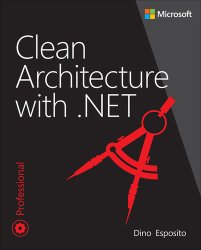Clean Architecture with .NET
- Добавил: literator
- Дата: 20-03-2024, 03:49
- Комментариев: 0
 Название: Clean Architecture with .NET
Название: Clean Architecture with .NETАвтор: Dino Esposito
Издательство: Microsoft Press/Pearson Education
Год: 2024
Страниц: 337
Язык: английский
Формат: pdf (true), epub
Размер: 16.9 MB
Master advanced .NET techniques with a focus on actual value delivered by working within a modular, clean architecture. Microsoft Data Platform MVP Dino Esposito explains key clean architecture concepts with a mix of pragmatism and design discipline and helps you solidify your knowledge through a real-world project. Starting with an explanation of the quest for modular software architecture continuing through the methodology of domain-driven design (DDD), Esposito emphasizes the role that modularization plays in managing complexity in software development. Breaking down the layers of an architecture that is modular and maintainable, he presents a sample project that is not simply another to-do list, but an actual tool for the reader. Ultimately, an exploration of common dilemmas for both developers and operations brings together historical developments with real solutions for today.
This book expects that you have at least a minimal understanding of .NET development and object-oriented programming concepts. A good foundation in using the .NET platform and knowledge of some data-access techniques will also help. We put great effort into making this book read well. It’s not a book about abstract design concepts, and it’s not a classic architecture book either, full of cross-references or fancy strings in square brackets that hyperlink to some old paper listed in a bibliography at the end of the book. It’s a book about building systems in the 2020s and facing the dilemmas of the 2020s, from the front end to the back end, passing through cloud platforms and scalability issues.
In all, modern software architecture has just one precondition: modularity. Whether you go with a distributed, service-oriented structure, a microservices fragmented pattern, or a compact monolithic application, modularity is crucial to build and manage the codebase and to further enhance the application following the needs of the business. Without modularity, you can just be able to deliver a working system once, but it will be hard to expand and update it.
Part I of this book, titled “The Holy Grail of modularity,” lays the foundation of software modularity, tracing back the history of software architecture and summarizing the gist of domain-driven design (DDD)—one of the most helpful methodologies for breaking down business domains, though far from being an absolute necessity in a project.
Part II, “Architecture cleanup,” is about the five layers that constitute, in the vision of this book, a “clean” architecture. The focus is not much on the concentric rendering of the architecture, as popularized by tons of books and articles, but on the actual value delivered by constituent layers: presentation, application, domain, domain services, and infrastructure.
Finally, Part III, “Common dilemmas,” focuses on three frequently faced stumbling blocks: monoliths or microservices, client-side or server-side for the front end, and the role and weight of technical debt.
The reference application requires .NET 8 and is an ASP.NET application with a Blazor front end. It uses Entity Framework for data access and assumes a SQL Server (any version) database.
Who should read this book:
Software professionals are the audience for this book, including architects, lead developers, and—I would say, especially—developers of any type of .NET applications. Everyone who wants to be a software architect should find this book helpful and worth the cost. And valid architects are, for the most part, born developers. I strongly believe that the key to great software passes through great developers, and great developers grow out of good teachers, good examples, and—hopefully—good books and courses. Is this book only for .NET professionals? Although all chapters have a .NET flavor, most of the content is readable by any software professional.
Скачать Clean Architecture with .NET (Developer Reference)
Внимание
Уважаемый посетитель, Вы зашли на сайт как незарегистрированный пользователь.
Мы рекомендуем Вам зарегистрироваться либо войти на сайт под своим именем.
Уважаемый посетитель, Вы зашли на сайт как незарегистрированный пользователь.
Мы рекомендуем Вам зарегистрироваться либо войти на сайт под своим именем.
Информация
Посетители, находящиеся в группе Гости, не могут оставлять комментарии к данной публикации.
Посетители, находящиеся в группе Гости, не могут оставлять комментарии к данной публикации.
